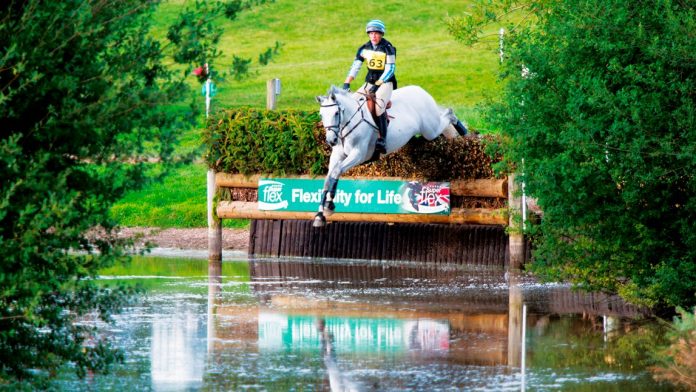Small adjustments can make big differences
Saddle fitters who read the feature and submit correct answers to the quiz will receive CPD recognition from the Society of Master Saddlers (SMS). Feature by Ken Lyndon-Dykes.
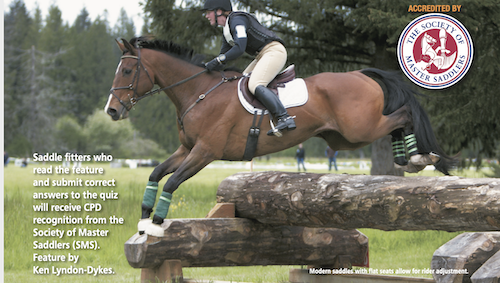
Modern saddles with flat seats allow for rider adjustment.
Ken Lyndon-Dykes: “The saddle influences the horse and the rider. The horse influences the rider and the saddle. The rider influences the saddle and the horse.”
Nelson Pessoa: “It isn’t what the saddle does for you, it’s what the saddle doesn’t do to you.”
Harvey Smith: “A general purpose saddle is nought and summat – take your pick!”
Thus it follows that when we think about the saddle in relation to the rider we must always remember that fitting the horse is the top priority.
Of course it is important that the saddle ‘fits’ the rider and that the design complements the needs of their chosen riding activity. The saddle must be suitable for the individual’s physique, afford comfort and have design attributes that can benefit the type of riding involved.
The saddle is a tool and it should assist the rider to achieve the very best of which they are capable in their chosen equestrian sport, discipline or recreational interest.
To achieve these goals, the saddle fitter requires comprehensive information about the type of riding in which the client is involved. It is just as important to get it ‘right’ for those who enjoy an occasional hack as it is for elite competition riders.
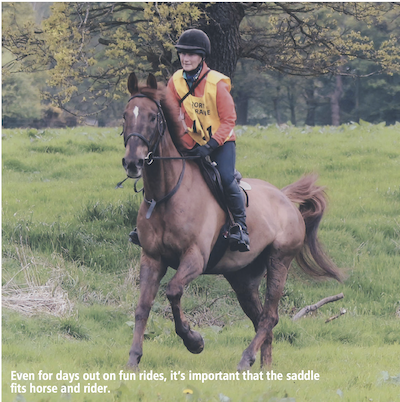
Saddle fitting demands a basic understanding of human anatomy as well as ability to assess riding skills. Rider ‘faults’ (unbalanced, sitting to one side, collapsing a hip, falling behind the movement, etc) inevitably impact on the saddle’s efficacy and thus affect the horse.
Having accepted the horse’s needs are always top priority, the saddle fitter requires accurate information about the rider. A small number of designs are better suited to either male or female riders. Height and the length of the rider’s inside leg are crucial factors.
The rider’s weight (ladies are occasionally reluctant to come clean!) is also fundamental - especially when considered in relation to the rider’s overall physique.
Balance is the prerequisite for successful riding at all levels: a rider who is top-heavy and has short legs will generally find it more difficult to remain in balance than the slim rider with long legs. Rider experience - novice, intermediate, advanced, international – is also an important factor.
Even for days out on fun rides, it’s important that the saddle fits horse and rider.
The saddle must allow the rider to remain (not force or clamp) in a balanced position at all times. Such is the huge diversity of saddles available today it is possible to equip virtually every rider with a really excellent tool - albeit with one notable exception: a rider whose substantial physique cannot be accommodated by their small, close-coupled horse.
Whatever type of riding is involved and at whatever level, during the fitting procedures the saddle fitter will shortlist a number of saddles and then ask the rider to try each of them (preferably in an indoor school, outdoor manege or fenced paddock) on both reins in walk, trot, canter and, in the case of a jumping saddle or a general purpose saddle used in part for jumping, over appropriate fences.
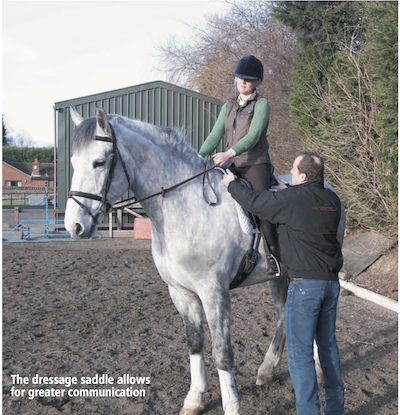
Depending on the number of short-listed saddles, this part of the fitting procedures can take a long time but it is crucial to selecting a saddle that fulfils the needs of rider and horse. Despite all the short-listed saddles having passed the off-load tests in relation to the horse, the saddle fitter may reject a saddle as unsuitable during these procedures. Finally, taking account of the comfort and performance of horse and rider, the saddle fitter and client then discuss the saddles that passed the ridden tests.
The industry invests time and money researching and developing saddle designs that benefit horse and rider. Way back when I was three-day eventing, the saddles we used across country were very forward cut, had big knee rolls and deep, deep seats. Thus it was virtually impossible to adjust position and, if a horse put in a very short or very long stride, the rider could be catapulted forward. It was also difficult to adjust over big drop fences and it’s fair to say that type of design failed to benefit performance.
It was my friend, the legendary show jumper Nelson Pessoa who told me we’d got it all wrong. It was he who designed the first less forward cut saddles with much flatter/shallower seats, small rolls and thin panels. Favoured by today’s riders, these design elements allow the rider to adjust position to suit changing circumstances – including emergencies.
Today’s saddles help the rider to maintain their centre of gravity over their base – fundamental to a secure position that gives the rider and the horse confidence.
Dressage requires the rider to sit on the seat-bones with a long leg in what is described as ‘the classical position’. Until relatively recently, dressage saddles had very deep seats that ‘clamped’ the rider into position. The high pommel and steep cantle ‘fixed’ the rider in what appears to be a good position but severely limits ability to influence the horse because the pelvis is tilted forwards, so positioning the seat bones against the forward flow of movement.
The dressage saddle allows for greater communication
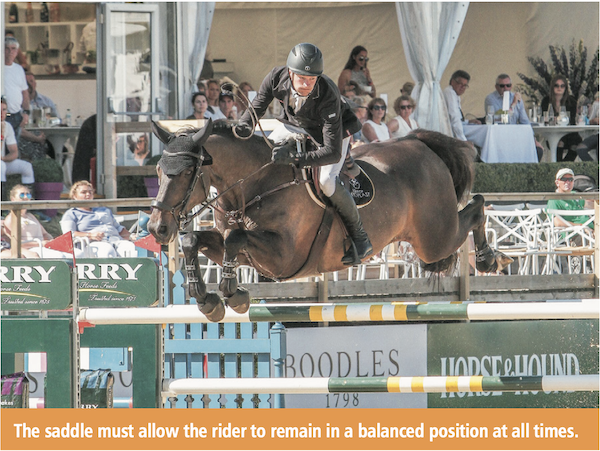
Today, there are hundreds of dressage saddles with shallow seats that allow the rider more freedom. Virtually all designs incorporate long, straight-cut flaps and stirrup bars mounted sufficiently far back to allow stirrups to hang vertically to accommodate a long leg position. Some saddle designs incorporate adjustable stirrup bars which afford flexibility, but it is unwise to assume that every rider understands which bar position is most suitable for them.
The saddle must allow the rider to remain in a balanced position at all times.
Sometimes the client unwittingly creates potential problems: say the desire for a saddle “just like my friend’s” - when it is obvious to the saddle fitter it is unsuitable for the client and/or the client’s horse! The client who is influenced by someone whose knowledge of saddle-fitting is non-existent or very limited is another problem.
I often think a qualification in psychology would be helpful. It would certainly be beneficial when it is necessary to explain to a client that a particular riding fault is impacting on the saddle and thus the horse.
Small adjustments can make big differences and it is for this reason the saddle fitters benefit from developing their knowledge of human and equine anatomy, physics and ergonomics. And of course, saddle fitting demands keeping up-to-date with changes and developments. Everything evolves, nothing stands still.
About the author:
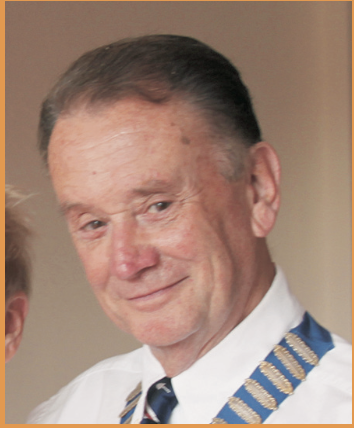
Ken Lyndon-Dykes is an SMS Qualified Saddle Fitter, holder of a BETA Lifetime Achievement Award and former international three-day event rider who specialises in fitting competition and problem horses. A former SMS president, Ken gives demonstrations and talks to equestrian groups and undertakes after-dinner speaking engagements on a wide variety of subjects. Ken has worked in many countries
and is frequently asked to act as a professional witness in equestrian-related court cases.










